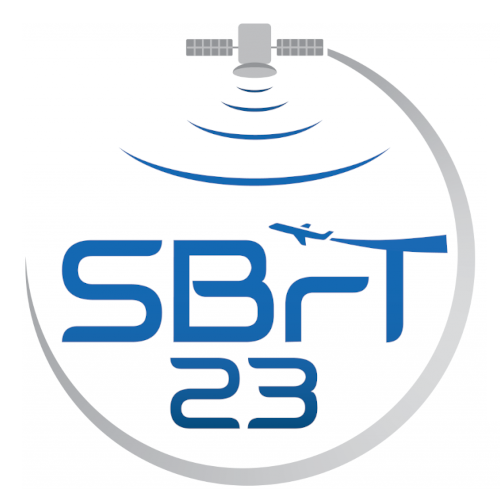
XLI Simpósio Brasileiro de Telecomunicações e Processamento de Sinais
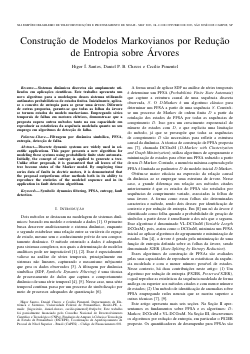
Construção de Modelos Markovianos por Redução de Entropia sobre Árvores
Higor I Santos, Daniel P B Chaves, Cecilio Pimentel
DOI: 10.14209/sbrt.2023.1570920905
Keywords: Filtragem por dinâmica simbólica PFSA Entropia Detecção de falha
Abstract
Sistemas dinâmicos discretos são amplamente utilizados em aplicações científicas. Este trabalho apresenta um novo algoritmo para a modelagem desses sistemas utilizando autômatos probabilísticos de estados finitos. Inicialmente, aplica-se o conceito de entropia para se gerar uma árvore. Diferente de outras propostas, garante-se que todas as folhas da árvore se tornem estados do modelo markoviano. Empregando séries temporais de falhas em motores elétricos, demonstra-se que a proposta supera outros métodos tanto na sua capacidade em reproduzir as estatísticas da sequência modelada quanto no seu emprego em algoritmos de detecção de falha.Download
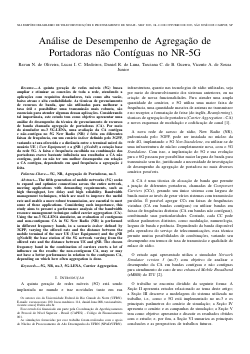
Análise de Desempenho Agregação de Portadoras não Contíguas no NR-5G
Ravan Oliveira, Vicente Sousa, Daniel R. de Luna, Tarciana C. de B. Guerra, Lucas Medeiros
DOI: 10.14209/sbrt.2023.1570921081
Keywords: 5G-LENA NR Carrier Aggregation ns-3
Abstract
The fifth generation of mobile networks (5G) seeks to expand and optimize connections across the entire network, meeting applications with demanding requirements, such as high throughput, low delay and high reliability. Bandwidth management techniques, which are used to improve the useful rate and enable a more robust transmission, are essential to meet some of these applications. Considering such importance, this study aims to present a performance analysis of the bandwidth resource management technique called carrier aggregation (CA). Using the ns-3 5G-LENA simulator, an evaluation of contiguous and non-contiguous CA in 5G New Radio (NR) is performed in different frequency bands, in a scenario \textit{indoor} defined by 3GPP, varying from the rate of offered and the distance between UE and gNB. The chosen frequency band in the combination of carriers exerts a lot of influence on the results, the non-contiguous CA may or may not have a better performance in relation to the contiguous CA, depending on which how often aggregation is done.Download
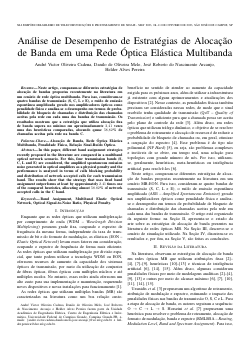
Análise de Desempenho de Estratégias de Alocação de Banda em uma Rede Óptica Elástica Multibanda
André Victor Oliveira Cadena, Danilo de Oliveira Melo, José Roberto do Nascimento Arcanjo, Helder A. Pereira
DOI: 10.14209/sbrt.2023.1570921383
Keywords: Alocação de Banda Rede Óptica Elástica Multibanda Penalidade Física Relação Sinal-Ruído Óptica
Abstract
Neste artigo, comparam-se diferentes estratégias de alocação de bandas propostas recentemente na literatura em um cenário de rede óptica multibanda. Para isso, consideram-se quatro bandas de transmissão (S, C, L e E), o ruído de emissão espontânea amplificada gerado nos amplificadores ópticos como penalidade física e analisa-se o desempenho em termos de probabilidade de bloqueio de chamadas e distribuição das chamadas aceitas pela rede em cada uma das bandas de transmissão. Os resultados mostram que a estratégia que utiliza alocação fixa de banda supera no mínimo em aproximadamente 2,41 vezes uma das heurísticas comparadas, alocando quase 58,82% de chamadas aceitas pela rede na banda C.Download

New Bound for Classical Zero-Error Capacity using Partially Commutative Monoids as Counting Tools
Andresso da Silva, Francisco M. Assis
DOI: 10.14209/sbrt.2023.1570922082
Keywords: Partially Commutative Monoid Zero-Error Capacity Partial Order
Abstract
In this paper we propose a new bound for the classical zero-error capacity of a communication channel using partially commutative monoids as enumeration tools. Specifically, we analyze the relationship between classical zero-error capacity and the growth factor of the monoid, \(\beta(G)\), of a graph \(G\). Although the value of \(\beta(G)\) allows us to calculate an upper bound for the classical zero-error capacity, determining it requires counting the number of cliques in a graph, which is an NP-Complete problem. Our main result is that the classical zero-error capacity is always lower than the integer part of \(\beta(G)\).Download
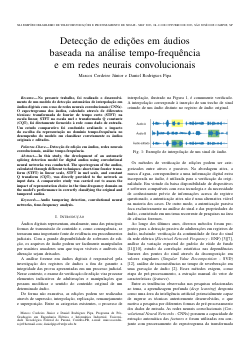
Detecção de edições em áudios baseada na análise tempo-frequência e em redes neurais convolucionais
Marcos Cordeiro Jr, Daniel Rodrigues Pipa
DOI: 10.14209/sbrt.2023.1570922439
Keywords: Audio tampering detection Convolutional neural networks Time-frequency analysis
Abstract
In this study, the development of an automatic splicing detection model for digital audios using convolutional neural networks was conducted. The spectrogram of the audios, calculated through different techniques: short-time fourier transform (STFT) in linear scale, STFT in mel scale, and constant Q transform (CQT), was directly provided to the network as input data. A comparative study was carried out to assess the impact of representation choice in the time-frequency domain on the model's performance in correctly classifying the original and tampered audios.Download

Affine Projection Adaptive Filters for the Identification of Sparse Systems
Cyro S. Hemsi
DOI: 10.14209/sbrt.2023.1570922443
Keywords: LMS Adaptive Filters System Identification Affine Projection
Abstract
In this paper, we focus on the identification of sparse systems, as is often the case in telecommunications and acoustics applications, using sparse affine projection (AP) algorithms, expected to perform better than sparse versions of the LMS and NLMS when the input signal is highly correlated. Initially, we offer a concise review on the AP adaptive filter theory, followed by the analysis of sparse AP zero attractor algorithms from a geometric point-of-view. Then, we propose a sparse AP based on the SparseStep approximation of the `0-pseudo-norm. Finally, the proposed algorithm is numerically validated by comparing it with well-known sparse AP filters.Download
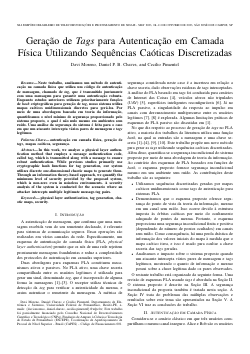
Geração de Tags para Autenticação em Camada Física Utilizando Sequências Caóticas Discretizadas
Davi C. M. de Almeida, Daniel P B Chaves, Cecilio Pimentel
DOI: 10.14209/sbrt.2023.1570922444
Keywords: autenticação em camada física geração de tags mapas caóticos segurança
Abstract
In this work, we analyze a physical layer authentication method that employs a message authentication code, called tag, which is transmitted along with a message to ensure robust authentication. While previous studies primarily use cryptographic hash functions for tag generation, our system utilizes discrete one-dimensional chaotic maps to generate them. Through an information theory-based approach, we quantify the minimum level of security provided by the proposed system, which is non-zero even in noiseless environments. A security analysis of the system is conducted for the scenario where an attacker intercepts multiple legitimate message-tag pairs.Download
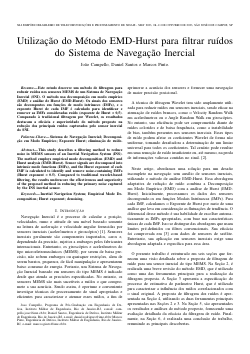
Utilização do Método EMD-Hurst para filtrar ruídos do Sistema de Navegação Inercial
Joao Vitor Campello, Daniel Santos, Marcos Pinto
DOI: 10.14209/sbrt.2023.1570922623
Keywords: Sistema de Navegação Inercial Decomposição em Modo Empírico Expoente Hurst eliminação de ruído
Abstract
Este artigo descreve um método de filtragem que visa reduzir os ruídos presentes nos sensores MEMS de um Sistema de Navegação Inercial (SNI). Ao empregar a técnica de Decomposição em Modo Empírico (EMD) e a análise do expoente Hurst, esse método é capaz de decompor o sinal ruidoso em componentes funcionais (IMFs) e aprimorar a supressão de ruído por meio de técnicas de limiarização. Comparado à tradicional filtragem por Wavelet, os resultados obtidos evidenciam a notável eficácia e superioridade do método proposto, cuja abordagem adaptativa permite reduzir com sucesso todos os principais ruídos captados pelo sensor inercial.Download
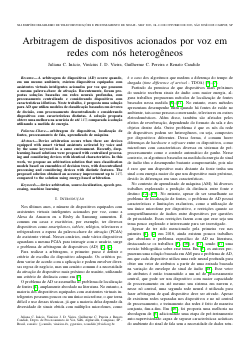
Arbitragem de dispositivos acionados por voz em redes com nós heterogêneos
Juliana C Inácio, Vinícius Jefferson Dias Vieira, Guilherme C Pereira, Renato Candido
DOI: 10.14209/sbrt.2023.1570922698
Keywords: arbitragem de dispositivos localização de fontes processamento de fala aprendizado de máquina
Abstract
A arbitragem de dispositivos ocorre quando em um mesmo ambiente existem dispositivos equipados com assistentes virtuais inteligentes acionados por voz que possuem a mesma palavra-chave de ativação. Recentemente, foram propostas soluções baseadas em redes neurais profundas, com processamento centralizado e considerando dispositivos com características idênticas. Neste trabalho, é proposta uma solução para arbitragem de dispositivos que utiliza modelos de classificação baseados em árvores de decisão, com processamento descentralizado e considerando dispositivos com características distintas. A solução proposta obteve uma melhora na acurácia de até 14% comparada a solução utilizando a medida de energia.Download
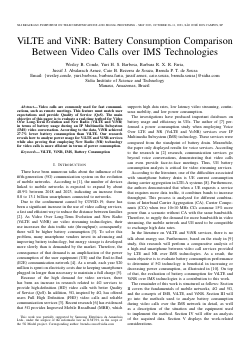
ViLTE and ViNR: Battery Consumption Comparison Between Video Calls over IMS Technologies
Wesley B. Conde, Brenda Sousa, Yuri hernan Santos Barbosa, Jussif Junior Abularach Arnez, Caio Bruno Bezerra de Souza, Bárbara Regina Xavier Ribeiro Faria
DOI: 10.14209/sbrt.2023.1570922702
Keywords: ViLTE ViNR IMS Battery Consuption
Abstract
Video calls are commonly used for fast communications, such as remote meetings. This feature must match user expectations and provide Quality of Service (QoS). The main objective of this paper is to evaluate a real-time testbed for ViLTE and ViNR in terms of battery usage during an IP Multimedia Subsystem (IMS) video conversation. According to data, ViNR achieved 27.7% lower battery consumption than ViLTE. Our research reveals how to analyze power usage for ViLTE and ViNR services while also proving that employing NR technology for video calls is more efficient in terms of power consumption.Download